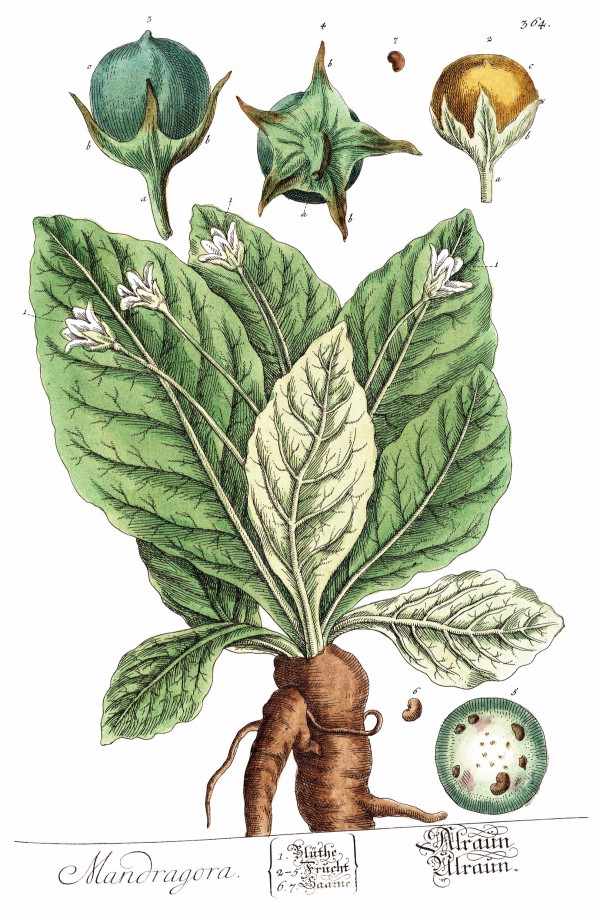Mandragora officinarum L. - syn. Atropa mandragora L., nom. illeg. - Solanaceae
mandrake, Devil's apples, Mandragora, Alraune
Prostrate perennial herb, native to the Mediterranean; taproot thick and often branched, sometimes resembling a human figure (legs, arms); leaves borne in a basal rosette, elliptic or obovate; petals greenish white to pale blue; fruit a globose or ovoid berry, glossy yellow to orange when ripe (resembling a small tomato).
„Because mandrakes contain deliriant hallucinogenic tropane alkaloids and the shape of their roots often resembles human figures, they have been associated with a variety of superstitious practices throughout history. They have long been used in magic rituals…“
https://en.wikipedia.org/wiki/Mandragora_officinarum
The fresh root sap (sweetened with honey) is used in former times internally as laxative, expectorant, cholagogue, and analgesic, but higher doses are (deadly) toxic. The fresh green leaves were crushed with malt to treat inflamed eyes and ulcers externally.
[Kreutterbuch, Leonhart Fuchs, 1543, Cap.CCI]
Alkaloids present in mandragora roots include atropine (R,S-hyoscyamine), scopolamine, scopine, apoatropine and belladonnines.
[Über die chemischen Bestandteile der Mandragorawurzel, 2.Die Alkaloide., Staub, H., Helvetica Chimica Acta, 45(7), 1962, 2297-2305]
The major odoriferous constituents of the fruits of mandrake (Mandragora officinarum L.) were ethylbutyrate (~22%), hexanol (~14%), butyl acetate (~9%) and hexyl acetate (~7%). An unusually high proportion of sulphur containing compounds (over 7%) contribute to the heavy, fruity and provocative odor of the mandrake fruit.
[The odoriferous principles of mandrake, Mandragora officinarum L., Fleisher, Z., Fleisher, A., Aromatic plants of the Holy Land and the Sinai. Part IX. Journal of Essential Oil Research, 4(2), 1992, 187-188]

Blackwell, E., Herbarium Blackwellianum, vol.4 t.364 (1760)
http://plantgenera.org/species.php?id_species=640257

Mandragora autumnalis Wikimedia Commons (author: Hedva Sanderovitz, copyright: public domain)
Mandragora autumnalis Bertol. - (placed to Mandragora officinarum by some authors) - Solanaceae
autumn mandrake, Herbst-Alraune, Mandragora
„The boundary between the two species Mandragora autumnalis and Mandragora officinarum varies among authors, with some regarding them as the same species… For those authors who regard Mandragora autumnalis as the main species found around the Mediterranean, it has flowers varying in colour but typically violet or purple, 30–40 mm (1–2 in) long, and berries that are yellow or orange and egg-shaped, while the much less widespread Mandragora officinarum has somewhat smaller flowers, greenish-white in colour, and berries that are yellow and globe-shaped.“ https://en.wikipedia.org/wiki/Mandragora_autumnalis
Mandragora autumnalis contains „…solanum alkaloids, which cause gastrointestinal irritation, and tropane alkaloids, which have anticholinergic properties and produce typical and sometimes severe atropine-like symptoms. Vital function support, decontamination, symptomatic treatment and, in severe cases, antidote therapy with physostigmine are useful to control acute poisoning.“
[Six clinical cases of Mandragora autumnalis poisoning: diagnosis and treatment., Piccillo, G.A., Mondati, E.G., Moro, P.A., European journal of emergency medicine, 9(4), 2002, 342-347]